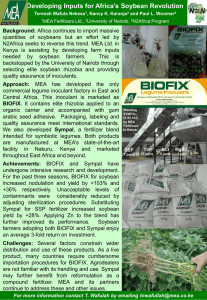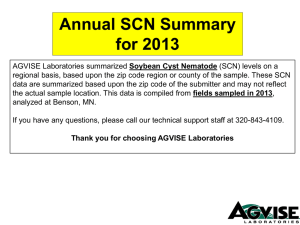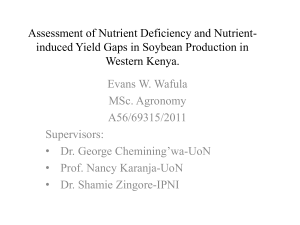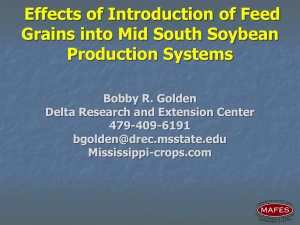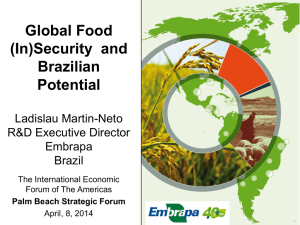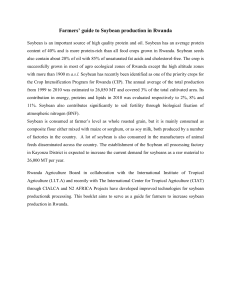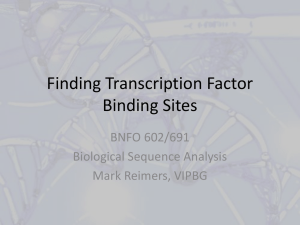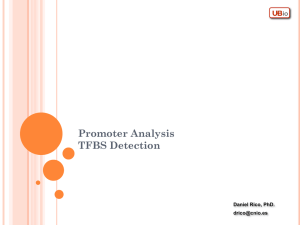pptx - George Mason University
advertisement
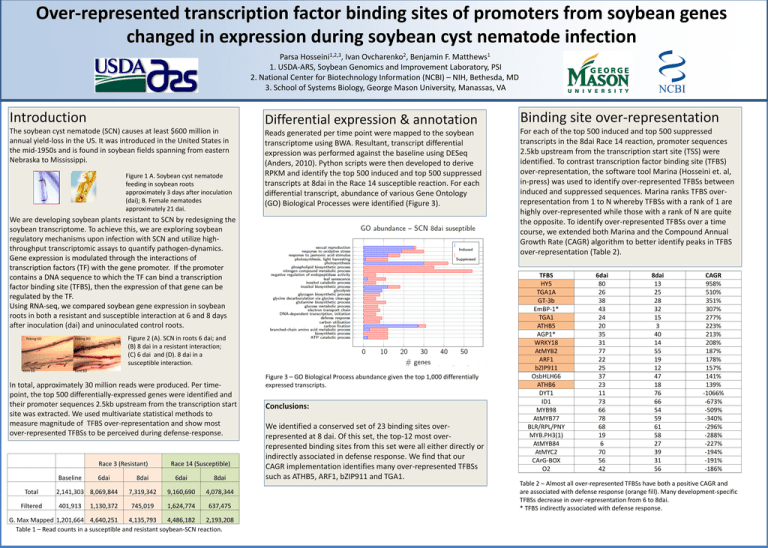
Over-represented transcription factor binding sites of promoters from soybean genes changed in expression during soybean cyst nematode infection 1,2,3 Hosseini , 2 Ovcharenko , 1 Matthews Parsa Ivan Benjamin F. 1. USDA-ARS, Soybean Genomics and Improvement Laboratory, PSI 2. National Center for Biotechnology Information (NCBI) – NIH, Bethesda, MD 3. School of Systems Biology, George Mason University, Manassas, VA Introduction Differential expression & annotation Binding site over-representation The soybean cyst nematode (SCN) causes at least $600 million in annual yield-loss in the US. It was introduced in the United States in the mid-1950s and is found in soybean fields spanning from eastern Nebraska to Mississippi. Reads generated per time point were mapped to the soybean transcriptome using BWA. Resultant, transcript differential expression was performed against the baseline using DESeq (Anders, 2010). Python scripts were then developed to derive RPKM and identify the top 500 induced and top 500 suppressed transcripts at 8dai in the Race 14 susceptible reaction. For each differential transcript, abundance of various Gene Ontology (GO) Biological Processes were identified (Figure 3). For each of the top 500 induced and top 500 suppressed transcripts in the 8dai Race 14 reaction, promoter sequences 2.5kb upstream from the transcription start site (TSS) were identified. To contrast transcription factor binding site (TFBS) over-representation, the software tool Marina (Hosseini et. al, in-press) was used to identify over-represented TFBSs between induced and suppressed sequences. Marina ranks TFBS overrepresentation from 1 to N whereby TFBSs with a rank of 1 are highly over-represented while those with a rank of N are quite the opposite. To identify over-represented TFBSs over a time course, we extended both Marina and the Compound Annual Growth Rate (CAGR) algorithm to better identify peaks in TFBS over-representation (Table 2). Figure 1 A. Soybean cyst nematode feeding in soybean roots approximately 3 days after inoculation (dai); B. Female nematodes approximately 21 dai. We are developing soybean plants resistant to SCN by redesigning the soybean transcriptome. To achieve this, we are exploring soybean regulatory mechanisms upon infection with SCN and utilize highthroughput transcriptomic assays to quantify pathogen-dynamics. Gene expression is modulated through the interactions of transcription factors (TF) with the gene promoter. If the promoter contains a DNA sequence to which the TF can bind a transcription factor binding site (TFBS), then the expression of that gene can be regulated by the TF. Using RNA-seq, we compared soybean gene expression in soybean roots in both a resistant and susceptible interaction at 6 and 8 days after inoculation (dai) and uninoculated control roots. Peking 6D Kent 6D Figure 2 (A). SCN in roots 6 dai; and (B) 8 dai in a resistant interaction; (C) 6 dai and (D). 8 dai in a susceptible interaction. Peking 8D Kent 8D In total, approximately 30 million reads were produced. Per timepoint, the top 500 differentially-expressed genes were identified and their promoter sequences 2.5kb upstream from the transcription start site was extracted. We used multivariate statistical methods to measure magnitude of TFBS over-representation and show most over-represented TFBSs to be perceived during defense-response. Race 3 (Resistant) Baseline Total Filtered 6dai 2,141,303 8,069,844 401,913 1,130,372 Race 14 (Susceptible) 8dai 6dai 8dai 7,319,342 9,160,690 4,078,344 745,019 1,624,774 637,475 G. Max Mapped 1,201,664 4,640,251 4,135,793 4,486,182 2,193,208 Table 1 – Read counts in a susceptible and resistant soybean-SCN reaction. Figure 3 – GO Biological Process abundance given the top 1,000 differentially expressed transcripts. Conclusions: We identified a conserved set of 23 binding sites overrepresented at 8 dai. Of this set, the top-12 most overrepresented binding sites from this set were all either directly or indirectly associated in defense response. We find that our CAGR implementation identifies many over-represented TFBSs such as ATHB5, ARF1, bZIP911 and TGA1. TFBS HY5 TGA1A GT-3b EmBP-1* TGA1 ATHB5 AGP1* WRKY18 AtMYB2 ARF1 bZIP911 OsbHLH66 ATHB6 DYT1 ID1 MYB98 AtMYB77 BLR/RPL/PNY MYB.PH3(1) AtMYB84 AtMYC2 CArG-BOX O2 6dai 80 26 38 43 24 20 35 31 77 22 25 37 23 11 73 66 78 68 19 6 70 56 42 8dai 13 25 28 32 15 3 40 14 55 19 12 47 18 76 66 54 59 61 58 27 39 31 56 CAGR 958% 510% 351% 307% 277% 223% 213% 208% 187% 178% 157% 141% 139% -1066% -673% -509% -340% -296% -288% -227% -194% -191% -186% Table 2 – Almost all over-represented TFBSs have both a positive CAGR and are associated with defense response (orange fill). Many development-specific TFBSs decrease in over-representation from 6 to 8dai. * TFBS indirectly associated with defense response.
